
Add an interceptor, set UUID as a unique identifier, and store it in the database
Query through the account of the current login
If the current If the UUID value stored in the user's session is the same as the UUID value in our database, pass
Otherwise, return false, indicating that the user has logged in on another device or browser
First we create a new Spring project
Add the following dependencies
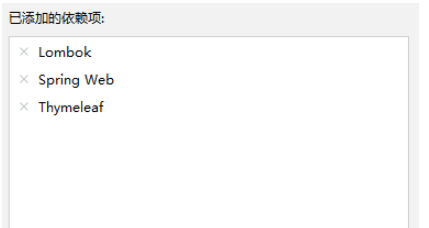
yml configuration file
server:
port: 8080
spring:
datasource:
driver-class-name: com.mysql.cj.jdbc.Driver
url: jdbc:mysql://127.0.0.1:3306 /userdb?characterEncoding=utf-8&&severTimezone=utc
username: root
password: root
thymeleaf:
mode: HTML5
cache: false
suffix: .html
prefix : classpath:/templates/
mybatis:
Mapper-locations: classpath:/mapper/*.xml #Introduce mapper files
type-aliases-package: com.bdqn.springsso.pojo #Introduce type aliases
pom.xml configuration file
<?xml version="1.0" encoding="UTF-8"?>
<project xmlns="http://maven.apache.org/POM/4.0.0" xmlns:xsi="http://www.w3.org/2001/XMLSchema-instance"
xsi:schemaLocation="http://maven.apache.org/POM/4.0.0 https://maven.apache.org/xsd/maven-4.0.0.xsd">
<modelVersion>4.0.0</modelVersion>
<parent>
<groupId>org.springframework.boot</groupId>
<artifactId>spring-boot-starter-parent</artifactId>
<version>2.7.5</version>
<relativePath/> <!-- lookup parent from repository -->
</parent>
<groupId>com.bdqn</groupId>
<artifactId>springsso</artifactId>
<version>0.0.1-SNAPSHOT</version>
<name>springsso</name>
<description>Demo project for Spring Boot</description>
<properties>
<java.version>1.8</java.version>
</properties>
<dependencies>
<dependency>
<groupId>org.springframework.boot</groupId>
<artifactId>spring-boot-starter-thymeleaf</artifactId>
</dependency>
<dependency>
<groupId>org.springframework.boot</groupId>
<artifactId>spring-boot-starter-web</artifactId>
</dependency>
<dependency>
<groupId>org.mybatis.spring.boot</groupId>
<artifactId>mybatis-spring-boot-starter</artifactId>
<version>2.2.2</version>
</dependency>
<dependency>
<groupId>com.mysql</groupId>
<artifactId>mysql-connector-j</artifactId>
<scope>runtime</scope>
</dependency>
<dependency>
<groupId>org.projectlombok</groupId>
<artifactId>lombok</artifactId>
<optional>true</optional>
</dependency>
<dependency>
<groupId>org.springframework.boot</groupId>
<artifactId>spring-boot-starter-test</artifactId>
<scope>test</scope>
</dependency>
</dependencies>
<build>
<plugins>
<plugin>
<groupId>org.springframework.boot</groupId>
<artifactId>spring-boot-maven-plugin</artifactId>
<configuration>
<excludes>
<exclude>
<groupId>org.projectlombok</groupId>
<artifactId>lombok</artifactId>
</exclude>
</excludes>
</configuration>
</plugin>
</plugins>
</build>
</project>Create the following packages in the java directory, and create the mapper package in resources

First write the pojo layer entity class User
Note: When creating a table in MySQL, the data type of uuid is varchar, and the length must be larger, otherwise it will run Report an error
package com.bdqn.springsso.pojo;
import lombok.Data;
@Data
public class User {
//用户id
private Integer id;
//账户
private String username;
//密码
private String password;
//uuid
private String uuid;
}Then write the mapper layer UserMapper interface
package com.bdqn.springsso.mapper;
import com.bdqn.springsso.pojo.User;
import org.apache.ibatis.annotations.Mapper;
import org.apache.ibatis.annotations.Param;
@Mapper
public interface UserMapper {
//根据姓名和密码查询
User chekLogin(@Param("username") String username, @Param("password") String password);
//根据姓名修改uuid
void update(@Param("uuid") String uuid,@Param("username") String username);
//根据姓名查询uuid
String getUUID(@Param("username") String username);
}Then write the service layer UserService and UserServiceImpl
package com.bdqn.springsso.service;
import com.bdqn.springsso.pojo.User;
public interface UserService {
//根据姓名和密码查询
User chekLogin(String username, String password);
//根据姓名修改uuid
void update(String uuid,String username);
}package com.bdqn.springsso.service;
import com.bdqn.springsso.mapper.UserMapper;
import com.bdqn.springsso.pojo.User;
import org.springframework.beans.factory.annotation.Autowired;
import org.springframework.stereotype.Service;
@Service
public class UserServiceImpl implements UserService {
@Autowired
private UserMapper userMapper;
@Override
public User chekLogin(String username, String password) {
return userMapper.chekLogin(username,password);
}
@Override
public void update(String uuid,String username) {
userMapper.update(uuid,username);
}
}Then write the interceptor layer UserInterceptor interceptor
package com.bdqn.springsso.interceptor;
import com.bdqn.springsso.mapper.UserMapper;
import org.springframework.web.servlet.HandlerInterceptor;
import javax.servlet.http.HttpServletRequest;
import javax.servlet.http.HttpServletResponse;
import javax.servlet.http.HttpSession;
public class UserInterceptor implements HandlerInterceptor {
private UserMapper userMapper;
public UserInterceptor(UserMapper userMapper){
this.userMapper=userMapper;
}
@Override
public boolean preHandle(HttpServletRequest request, HttpServletResponse response, Object handler) throws Exception {
HttpSession session = request.getSession();
String username = (String) session.getAttribute("username");
//数据库
String UUID=userMapper.getUUID(username);
//session
String uuid = (String)session.getAttribute("uuid");
System.out.println("uuid = " + uuid);
System.out.println("UUID = " + UUID);
if(UUID.equals(uuid)){
return true;
}else {
System.out.println("拦截"+request.getRequestURI());
response.sendRedirect("/login");
response.setStatus(401);
return false;
}
}
}Then the controller layer UserController
package com.bdqn.springsso.controller;
import com.bdqn.springsso.pojo.User;
import com.bdqn.springsso.service.UserService;
import org.springframework.beans.factory.annotation.Autowired;
import org.springframework.stereotype.Controller;
import org.springframework.web.bind.annotation.CrossOrigin;
import org.springframework.web.bind.annotation.RequestMapping;
import org.springframework.web.bind.annotation.ResponseBody;
import javax.servlet.http.HttpSession;
import java.util.UUID;
@Controller
@CrossOrigin
public class UserController {
@Autowired
private UserService userService;
//登录
@RequestMapping("/")
public String goLogin(){
return "login";
}
//登录验证
@RequestMapping("/login")
public String chekLogin(String username, String password, HttpSession session){
User user=userService.chekLogin(username,password);
if (user==null){
return "login";
}else {
session.setAttribute("username",username);
String uuid= UUID.randomUUID().toString().replace("-", "");
System.out.println("uuid = " + uuid);
userService.update(uuid,username);
session.setAttribute("uuid",uuid);
return "index";
}
}
//测试
@RequestMapping("/test")
@ResponseBody
public String test(){
return "成功";
}
}Then the writing of the config layer MvcConfig
package com.bdqn.springsso.config;
import com.bdqn.springsso.interceptor.UserInterceptor;
import com.bdqn.springsso.mapper.UserMapper;
import org.springframework.beans.factory.annotation.Autowired;
import org.springframework.context.annotation.Configuration;
import org.springframework.web.servlet.config.annotation.InterceptorRegistry;
import org.springframework.web.servlet.config.annotation.WebMvcConfigurer;
@Configuration
public class MvcConfig implements WebMvcConfigurer {
@Autowired
private UserMapper userMapper;
@Override
public void addInterceptors(InterceptorRegistry registry) {
//添加拦截器,排除/路径和 /login路径
registry.addInterceptor(new UserInterceptor(userMapper))
.excludePathPatterns("/","/login");
}
}The last is the writing of userMapper.xml
<?xml version="1.0" encoding="UTF-8" ?>
<!DOCTYPE mapper
PUBLIC "-//mybatis.org//DTD Mapper 3.0//EN"
"http://mybatis.org/dtd/mybatis-3-mapper.dtd">
<mapper namespace="com.bdqn.springsso.mapper.UserMapper">
<update id="update">
update user set uuid=#{uuid} where username=#{username}
</update>
<select id="chekLogin" resultType="com.bdqn.springsso.pojo.User">
select * from user where username=#{username} and password=#{password}
</select>
<select id="getUUID" resultType="java.lang.String">
select uuid from user where username=#{username}
</select>
</mapper>login.html
<!DOCTYPE html>
<html lang="en" xmlns:th="http://www.thymeleaf.org">
<head>
<meta charset="UTF-8">
<title>Login Module</title>
</head>
<body>
<h2 >欢迎来到登录页面</h2>
<form th:action="@{/login}" method="post">
用户:<input type="text" name="username"><br>
密码:<input type="password" name="password"><br>
<button type="submit">登录</button>
</form>
</body>
</html>index.html
<!DOCTYPE html>
<html lang="en" xmlns:th="http://www.thymeleaf.org">
<head>
<meta charset="UTF-8">
<title>Title</title>
</head>
<body>
<h2>登录成功</h2>
<a th:href="@{/test}" rel="external nofollow" >测试</a>
</body>
</html>First we use Firefox browser to operate
Enter http:// localhost:8080/Enter the login page
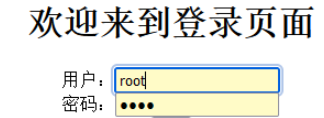


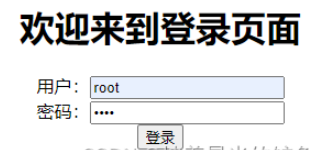
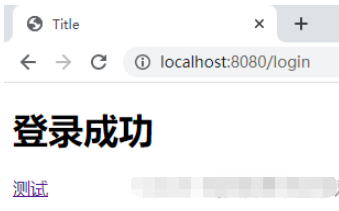
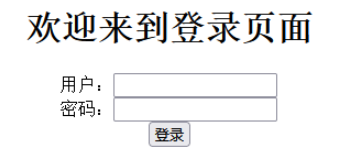
The above is the detailed content of How to implement SpringBoot single sign-on. For more information, please follow other related articles on the PHP Chinese website!
 SpringBoot project building steps
SpringBoot project building steps
 What is the difference between j2ee and springboot
What is the difference between j2ee and springboot
 How to solve the problem that localhost cannot be opened
How to solve the problem that localhost cannot be opened
 What are the common testing techniques?
What are the common testing techniques?
 What are the basic data types in php
What are the basic data types in php
 Word document encryption tutorial
Word document encryption tutorial
 Ranking of the top ten digital currency exchanges
Ranking of the top ten digital currency exchanges
 How to raise a little fireman on Douyin
How to raise a little fireman on Douyin




